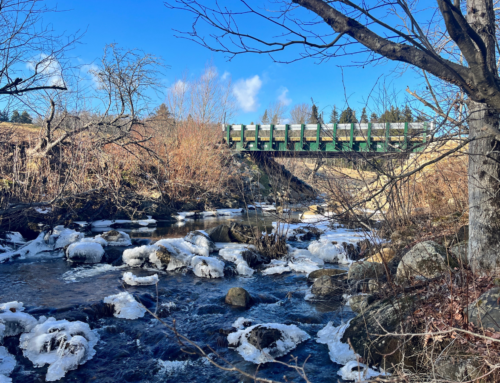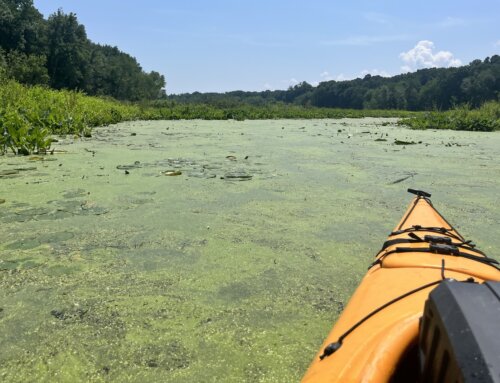Groundwater: despite being out of sight,
it should never be out of mind
SEPTEMBER 2008 — Where is Leaky Acres and why should you care? In order to get there from here we need talk about groundwater.
Groundwater is the hidden treasure flowing beneath our feet. Scientists estimate that groundwater comprises 30% of all the freshwater on earth. That’s a lot when compared to only 0.3% available in surface freshwater. The rest of the freshwater is in the icecaps and glaciers at 68.7% and water vapor at 1%. Groundwater is a vital resource here in our Connecticut River Valley as at least 2/3 of all households rely on it.
How does groundwater come to exist? Rain does not stop falling when it hits the ground. Gravity brought the rain to the ground and gravity keeps it moving downward through the soil. As water seeps into the ground some clings to soil particles or plant roots. This is the moisture plants need to grow. Water that does not runoff overland into a water body or is not used by plants continues to move deeper into the ground.
The water moves downward through spaces or cracks in the soil or rocks until it reaches a layer through which water cannot pass. As more water collects above this impervious horizon eventually it fills all the empty spaces and cracks above that layer. An underground storage area that can supply a usable amount of groundwater is an aquifer. The highest level to which the water collects in the soil or rocks is called the water table.
Groundwater is usually in motion from upland recharge areas to lower discharges and flow rates can range from inches per year to feet per minute. At least some ground water can be found almost everywhere. Undisturbed, groundwater will arrive at a natural balance with the water table rising or falling depending on recharge rates that increase with heavy rains or melting snow or decrease in dry weather.
Although the initial collection of groundwater is downwards, groundwater can move upwards. Groundwater occurs in aquifers under two conditions: confined and unconfined. An unconfined aquifer is a layer of permeable soil sitting on top of an impermeable layer of clay or rock over which the water collects. A confined aquifer is positioned between two layers of impermeable clay or rock. Confined aquifers are often recharged through cracks or openings in their top layer or through fractured rock some distance away. A confined aquifer following a downward grade pressurizes the groundwater as it flows. This can create artesian wells that flow freely without the need of a pump.
Usually groundwater is thought of as liquid water flowing through aquifers, but technically it also includes permafrost and deep geothermal water. Groundwater is hypothesized to provide lubrication that can influence the movement of tectonic plates along faults.
Aquifers also interact with streams sometimes delivering water into a stream or lake. The specific heat characteristic of water allows its temperature to remain somewhat stable. That combined with the insulating effect of soil and rock maintains groundwater at a relatively steady temperature at about 50 degrees F. This cool water when it enters a river during high summer water temperatures provides refuge for fish and in the winter it protects fish eggs and macroinvertebrate life by preventing ice from freezing all the way to the bottom of a river. Anchor ice as it is known will kill all life on a river bottom.
Since groundwater percolates down through the land, our land uses affect its quality and quantity. Agriculture installations such as drainage systems reduce infiltration. The impervious surfaces of buildings, roads and parking lots decrease infiltration. A quick inventory of pollution sources are the same as surface water threats: road salt and snow dumping – chloride contamination; improper manure handling and home lawn fertilizing – nitrate and pathogen contamination; improperly operating septic systems – nitrate and pathogen contamination; industrial uses – toxics and carcinogens contamination and junkyards and gas stations – hydrocarbon and carcinogens contamination.
And then there is the overuse of groundwater and now we have arrived at Leaky Acres. Leaky Acres is a groundwater recharge project located in Fresno California. In the 1960s Fresno depleted its groundwater supply. In 1970 they built 26 ponds covering 200 acres. The sole function of Leaky Acres is to hold water drawn from nearby rivers until it percolates into the ground to recharge the groundwater. Fresno gives tours of Leaky Acres if you are ever in the area. And while you are in California you also might stop by Orange County’s project to restore their depleted groundwater supply. Orange County pumps their treated sewage into a holding reservoir to allow it to percolate down into their drinking water aquifer. Hmmm….. Sewage to groundwater, maybe we should just protect what we have here naturally.
David Deen is River Steward for the Connecticut River Watershed Council. CRC has been an articulate voice for the Connecticut River for more than half a century.
[/fusion_builder_column][/fusion_builder_row][/fusion_builder_container]







